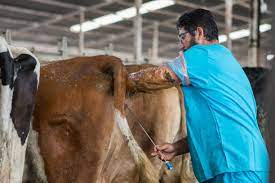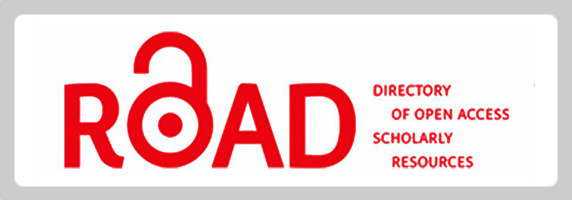Review on Major Factors that Influence the Success of Artificial Insemination
Factors affecting the efficiency of AI
Abstract
Artificial insemination (AI) is the first and oldest biotechnological technology for livestock genetic improvement, and it involves inserting sperm into the female's reproductive canal without using natural mating. It's one of a group of technologies known as assisted reproduction technologies (ART), in which babies are produced by enabling the meeting of male and female gametes. Ethiopia has Africa's largest livestock population and a huge potential for dairy production expansion due to the country's favourable climate, which encourages the use of upgraded, high-yielding animal breeds and provides a disease-free environment for livestock development. Over the last four decades, development and research programs have introduced genetic enhancement of indigenous cattle through crossbreeding employing AI technology. However, due to factors such as the AI delivery system, heat detection and time of insemination, intrinsic factors associated with the cow, early embryonic losses, management issues, semen quality, insemination techniques, and lack of awareness, AI technology was not successful in improving cattle reproductive efficiency. As a result, to build a successful technology, the above-mentioned aspects must be resolved to the optimum stage of the technology requirement.
Downloads
References
Abriham Kebede. (2018). Review on Factors Affecting Success of Artificial Insemination. Int.J.Curr.Res.Aca.Rev. 6(5), 42-49.
Anzar M., Farooq U., Mirza M.A., Shahab M. and Ahmad N. (2003). Factors Affecting the Efficiency of Artificial Insemination in Cattle and Buffalo in Punjab. Pakistan Veterinary Journal, 23(3): 106-113.
Arthur G.H. (2001). Arthur's Veterinary Reproduction and Obstetrics. Eighth edition. Pp. 430- 767
Ashebir, G. (2016). Status of Artificial Insemination in Tigray Regional State, “Constraints and Acceptability under Field Condition”. Journal of Dairy, Veterinary & Animal Research, 3(3).
Baheriw, Z., Birhan, M., Fentahun, T., 2013. Assessment on Problems Associated with Artificial Insemination Services in West Gojjam Zone , Ethiopia Department of Basic Veterinary Science, 7, 59–66. https://doi.org/10.5829/idosi.abr.2013.7.2.72142
Barros CM, Pegorer MF, Vasconcelos JLM, Bruno GE and Fabio MM (2006): Importance of sperm genotype (Indicus versus Taurus) for fertility and embryonic development at elevated temperatures. Theriogenology, 65: 210–218.
Bekana, M. (1991). Farm Animals Obstetrics. Monograph, Faculty of Veterinary Medicine, Addis Ababa University.
Bekana, M., Tegegne, A., Belihu, K., 2007. Status of Artificial Insemination Service in Ethiopia 344.
Birhanemeskel, A., Kide, W., 2018. Participatory Evaluation of Artificial Insemination ( AI ) Service Delivery and Semen Quality in Northern Ethiopia 11, 589–595. https://doi.org/10.30954/0974-1712.06.2018.23
Chebel, R.C., Santos J. E.P., Reynolds J.P., Cerri R.L.A., Juchem S.O. and Overton, M. (2004): Factors affecting conception rate after artificial insemination and pregnancy loss in lactating dairy cows. Animal Reproduction Science, 84: 239–255.
Dalton JC (2011): Strategies for Success in Heat Detection and artificial Insemination. Advances in Dairy Technology, 23:215-229.
Dhaliwal G.S., Murray R.D., Dobson H. (1996). Effects of Milk Yield and Calving to First Service interval, in Determining herd Fertility in Dairy Cows. Animal Reproduction Science 41 : 109- 117.
Dobbins C.A.; Eborn D.R.; Tenhouse D.E.; Breiner R.M.; Johnson S.K.; Marston T.T.; Stevenson J.S., 2009. Insemination timing affects pregnancy rates in beef cows treated with CO-Synch protocol including an intravaginal progesterone insert DOI: 10.1016/j.theriogenology.2009.06.025
Engidawork, B., 2018. Artificial Insemination Service Efficiency and Constraints of Artificial Insemination Service in Selected Districts of Harar National Region 239–251. https://doi.org/10.4236/ojas.2018.83018
Funston R. N., Larson D. M. and Vonnahme k. A. (2009). Implications for beef cattle production effects of maternal nutrition on conceptus growth and offspring performance: Journal of anmal science, 88: 205-215.
Galina C.S., Orihuela A., Rubio I. (1996). Behavioural Trends Affecting Oestrus Detection in Zebu Cattle. Animal Reproduction Science 42: 465-470.
Gebremedhin, D. (2008): Assessment of Problems/Constraints Associated with Artificial Insemination Service in Ethiopia. Msc thesis, Addis Ababa University, Faculty of veterinary medicine, DebreZeit, Ethiopia
Gizaw, T., Dima, F.G., 2016. Journal Of Harmonized Research ( JOHR ) ASSESSMENT OF PROBLEMS AND CONSTRAINTS ASSOCIATED WITH ARTIFICIALIN 3, 14–37.
Grimard B., Freret S., Chevallier A., Pinto A., Ponsart C., Humblot P. (2006). Genetic and Environmental factors Influencing First Service Conception rate and Late Embryonic/foetal Mortality in Low Fertility Dairy herds. Animal Reproduction Science 91: 31–44
Haugan T., Reksen O., Gr¨ohn Y.T., Kommisrud E., Ropstad E., Sehested E. (2005). Seasonal Effects of Semen Collection and Artificial Insemination on Dairy Cow Conception. Animal Reproduction Science 90: 57–71
Heinonen, M. (1989). Artificial Insemination of Cattle in Ethiopia. Ministry of Agriculture Bulletin. Pp. 71-103
IFTIKHAR A.A., USMANI R.H., TUNIO M. T. AND ABRO S.H. (2009). IMPROVEMENT OF CONCEPTION RATE IN CROSSBRED CATTLE BY USING GNRH ANALOGUE THERAPY. Department of Agricultural Sciences, Islamabad; pakistan veterinary. Journal., 29 : 93-94.
Jane, A. P., Rhonda, C. and Jamie, E. L. (2009): Estrus Detection in cattle. Animal and Dairy Sciences Article: Brown Loam Branch Research and Experiment Station, Mississippi State University Extension Service.
James F. R. (2006). The effect of nutritional management of the dairy cow on reproductive efficiency. Animal Reproduction Science 96: 282–296
Jemal, H., Lemma, A., 2015. Review on Major Factors Affecting the Successful Conception Rates on Biotechnological Application (Ai) in Cattle 15.
Kebede, A., 2018. and Academic Review 6, 42–49.
Length, F., 2016. Study of productive and reproductive performance of cross breed dairy cattle under smallholders management system in Bishoftu and Akaki Towns 6, 913–917.
Lemma, A. (2011): Effect of Cryopreservation on Sperm Quality and Fertility. Addis Ababa University, School of Veterinary Medicine, Debrezeit, Ethiopia: In Artificial Insemination in Farm Animals. First Edition, Pp. 191-216
Lobago, F., Bekana, M., Gustatsson, H., Kindahl, H. (2006): Reproductive performance of dairy cow in small holder production system in Selalle, central Ethiopia. Trop. Anim. Health Prod., 38: 333-342.
López-Gatius F. 2000. Site of semen deposition in cattle: a review. Theriogenology, 53:1407-1414.
López-Gatius F., (2011). Feeling the ovaries prior to insemination. Clinical implications for improving the fertility of the dairy cow. Department of Animal Production, Theriogenology 76: 177–183.
López-Gatius F.and Camón-Urgel J. 1988. Increase of pregnancy rate in dairy cattle after preovulatory follicle palpation and deep cornual insemination. Theriogenology, 29(5):1099-103.
Masama, E., Kusina, Kt., Sibanda, S., Maioni, C. (2003): Reproduction and lactation performance in a small holder diary system in Zimbabwe. Trop. Anim. Health Prod., 35, 117-129.
Medicine, V., 2018. International Journal of Advanced Research in Biological Sciences Assessment of Efficiency and Major Constraint of Artificial Insemination Service in Small Holder Dairy Farmers in and around Adama Town 5, 88–99. https://doi.org/10.22192/ijarbs
Mekonnen T., Bekana M. and Abayneh T. (2010). Reproductive performance and efficiency of artificial insemination smallholder dairy cows/heifers in and around Arsi-Negelle, Ethiopia. Faculty of veterinary medicine, Addis Ababa university, livestock research for rural development 22 , 1-5.
Meles, G-M. and Heinonen, K. (1991). Artificial Insemination Results in Tegulatina Bulga Awraja, Institute of Agriculture Research, A Monograph, Addis Ababa. Pp. 97-99.
Melesse, K., Jemal, J., Melesse, A., 2013. Factors affecting the level of adoption of dairy technologies in Ada ’ a and Lume Districts , East Shoa- Ethiopia 3, 237–243.
Milad M. (2011). Artificial Insemination in Farm Animals. First Edition. Pp. 153-166.
Mukasa-Mugerewa, E., (1989). A Review of Reproductive Performance of Female Bos indicus (zebu) cattle, International Livestock Centre for Africa (ILCA), Monograph, No.6 Addis Ababa, Ethiopia. Pp 1-13.
Ntombizakhe, M. (2002): The Importance of breeding infrastructure and support services: The success/ failure of artificial insemination as a method of disseminating genetic material to small holder dairy farmers in Southern Africa. ZaBelo livestock consultancy, Bulawayo, Zimbabwe, from: http://agtr.ilri.cgiar.org/index.php? option=com_content&task=view&id=78&Itemid=95.
O’Connor L.M., (1993). Heat Detection and timing of insemination for cattle, the Pennsylvania state university, Agricultural Research and cooperatives Extension. A monograph. Pp 1-17.
O‘Connor, L.M. (2003): Reviewing Artificial Insemination Technique. The Pennsylvania State University. Agricultural Research and Cooperative Extension; A monograph, Pp. 1-6.
Rahim, M.A. and Asghar, S. (2007): Evaluation of the Treatment of Repeat Breeder Dairy Cows with Uterine Lavage plus PGF2a, with and without Cephapirin. Journal of Veterinary Animal Science, 31:125-129.
Rodriguez-Martinez, H. (2000). Evaluation of Frozen Semen:Traditional and New approaches: In the topic of Bull Fertility. International Veterinary Information Service, pp.1-4
Roelofs J.B., Graat E.A.M., Mullaart E., Soede N.M., Voskamp-Harkema W., Kemp B. (2006). Effects of insemination–ovulation interval on fertilization rates and embryo characteristics: In dairy cattle Quantitative Veterinary Epidemiology, Wageningen University. Pp.2173-2181
Roelofs, J. B., F. López-Gatius, R. H. F. Hunter, F. J. C. M. van Eerdenburg, and Ch. Hanzen. 2010. When is a cow in estrus? Clinical and practical aspects. Theriogenology 74:327–344
Roelofs J.B., Van Eerdenburg F.J.C.M., Soede N.M., Kemp B. (2005). Various Behavioral Signs of Estrous and their Relationship with time of Ovulation in Dairy cattle Adaptation Physiology. Wageningen and Utrecht Universities. The Netherlands. Theriogenology 63:1366–1377.
Rogers, P. (2001): Bovine fertility and control of herd infertility. Grange Research Centre, Dunsany, Co. Meath, Ireland, http://homepage.eircom.net/~progers/infertil.htm
Saacke R.G. (2008). Insemination factors related to timed AI in cattle. Department of dairy science, Theriogenology 70. Pp. 479–484
Senger PL, Becker WC, Davidge ST, Hillers JK, Reeves JJ. 1988. Influence of cornual insemination on conception in dairy cattle. J Anim Sci, 66:3010-3016.
Senger PL. 1993. Site of semen deposition and its effect on fertility and sperm retention: a review. Reprod Fertil Dev, 5:659-663.
Shiferaw Y., Tenhagen B.A., Bekana M. and Kasa T. (2003): Reproductive performance of crossbred dairy cows in different production systems in the central highlands of Ethiopia. Trop Anim Health Prod. 25, 551-561.
Tenhagen, R., Kuchenbuch, S. and Heuwieser, W. 2005. Timing of ovulation and fertility of heifersafter synchronization of oestrus with GnRH and Prostaglandin F2a. Reprod. Domestic Anim. 40: 62-67.
Yehalaw, B., Jemberu, A., Asnake, A., Wube, A., Hirpa, A., Medicine, V., Box, P.O., 2018. Factors Affecting the Efficiency of Artificial Insemination in Dairy Cows in and Around Bishoftu ( Debre Zeite ), Oromia Regional State , Ethiopia 9, 28–35. https://doi.org/10.5829/idosi.jri.2018.28.35

Copyright (c) 2022 Mosisa Dire Babura

This work is licensed under a Creative Commons Attribution-NonCommercial-NoDerivatives 4.0 International License.










